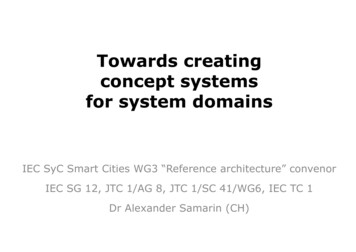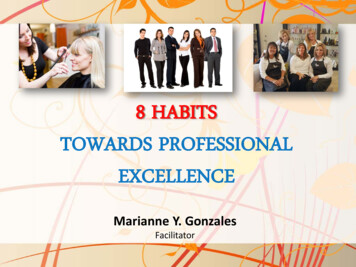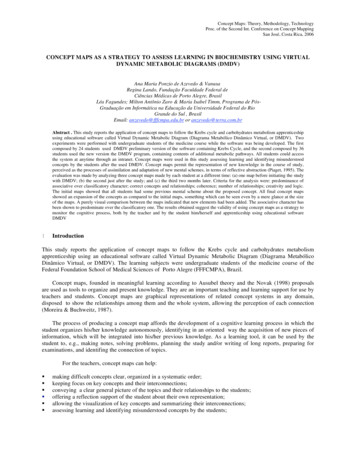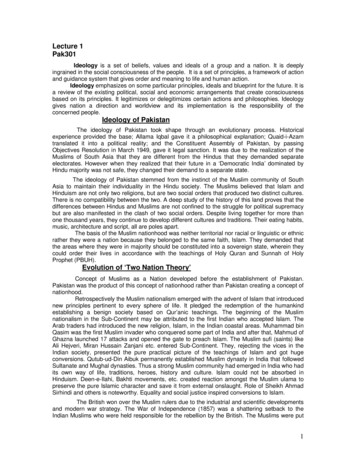
Transcription
Towards creatingconcept systemsfor system domainsIEC SyC Smart Cities WG3 “Reference architecture” convenorIEC SG 12, JTC 1/AG 8, JTC 1/SC 41/WG6, IEC TC 1Dr Alexander Samarin (CH)
Different types of viewpoints(following IEC/IEC/IEEE 42010:2011)1. Structure – Smart Citiesare SOMETHING (elements)2. Aspect – Smart Cities exhibitSOMETHING (characteristics)3. Perspective – Smart Cities as onlySOMETHING (sone artefacts)Smart City as an IoT‐centric applicationSmart City as a cyber‐physical system4. Aggregation – Smart Cities as a full collectionof SOMETHING (all primitive artefacts)2021-04-15Towards creating concept systems for system domains2
A set of viewpoints (11) and modeltypes (107) VALUE viewpoint BIG PICTURE viewpoint SYSTEM-SOLUTION ENGINEERING viewpoint PLATFORM ENGINEERING viewpoint PLATFORM COMPONENT ENGINEERING viewpoint SOLUTION ENGINEERING viewpoint CROSSCUTTING ASPECTS ENGINEERING viewpoint CORPORATE viewpoint RISK MANAGEMENT viewpoint SOFTWARE FACTORY viewpoint STANDARDS viewpoint2021-04-15Towards creating concept systems for system domainsTOGAFDoDAFBIZBokBABokJTC1/SC7CoBITITSM, ITIL, ISO 20000ISO 27000ISO 9000BPMBoKPMBokDevOpsAgileSCRUMRM‐ODPITU unified security3
VALUE viewpoint(nothing about IT and outside-in viewpoint)2021-04-15Towards creating concept systems for system domains4
The context for IEC SyC “Smart Cities” We found many models (includingconcept ones) for Smart Cities, whichcan’t be used together All system domains from IEC, ISO, JTC1 are developedwith different terminologiesSmartManufacturingSmart rtHomesAALActive Assisted Livingfor people withdisabilities and theelderlyAI2021-04-15 BigDataTowards creating concept systems for system domainsIoT5
Many views from many stakeholders inmany disciplines2021-04-15Towards creating concept systems for system domains6
The problem The complexity– each system domain is multidisciplinary– a system domain concept system is a composition of manyconcepts from various concept systems - from other system domainsand subject fields An example – 40 concepts for IEC 60050-831 “Smart Cities”– 1 concept (“city”) has to be clarified– 1 concept (“smart city”) has to be defined (even derived)– 35 concepts to be borrowed from other domains and subject fields– 3 concepts are joint two concepts – they need only examples The problem – how to create and maintain a system domain(e.g. Smart Cities) concept system efficiently and effectively2021-04-15Towards creating concept systems for system domains7
Potential solution outline Theory– Terminology– Ontology– Graphs (sets of vertices and edges) Method– Decomposition into a set of concept systems with an explicitownership– Procedure for assembling a new concept system from existingconcept systems Tooling Externalising within the IEC SyCs Externalising within the IEC TCs Externalising within the international standardisation2021-04-15Towards creating concept systems for system domains8
Decomposition into a set of concept systemsCommonly agreeddecomposition of systemdomains and subject fields (IEC60050 is a perfect base)Concept systemSystem domain 1Concept systemSystem domain 3Concept systemSubject field 5Concept systemSubject field 9Concept systemSubject field 8Linguistic dictionary2021-04-15Towards creating concept systems for system domains9
Understanding of potential conflictsConcept systemSystem domain 1Term 1.3Concept systemSystem domain 3Term 1.8Term 3.4Term 5.7Concept systemSubject field 9Term 9.10Term 8.1Concept systemSubject field 5Concept systemSubject field 8Potential conflicts:‐ same term and different definitions‐ same definition and different termsLinguistic dictionary2021-04-15Towards creating concept systems for system domains10
Procedure to avoid conflicts “by-design” Each concept system is made as a planar directed acyclicgraph Consistency of each concept system is formally validated(we need a tool, ideally, ontology based) Several agreed rules are used for assembling a newconcept system from existing concept systems– adopting an existing concept– modifying an existing concept– defining a new concept All concept systems and their elements are versioned IEC terminology rules to be adapted for systems work2021-04-15Towards creating concept systems for system domains11
Clusters of system domain Level 1 Societal (social-technological) cluster––––Smart ManufacturingSmart CitiesDigital Healthcare ––––––Smart EnergyLVDCSmart BuildingsSmart HomesActive Assisted LivingIntelligent Transportation System Level 3 Technology cluster–––––––––Level 4 Transversal cluster–––––––––Level 2 Verticals cluster– TerminologySystems approachDigital TransformationArchitectingOrganisation of workOrganisation of societyUrbanITOperations––Trustworthiness –MiscellaneousLevel 5 Universal clusterIoTCloud computingBlockchainBigData and AICommunication Technologies and ArchitecturesInformation SecurityTrustworthinessDigital Twins 2021-04-15Towards creating concept systems for system domains12
Questions? E-mail: alexandre.samarine@gmail.com Mobile: 41 76 573 40 612021-04-15Towards creating concept systems for system domains13
CoBIT ITSM, ITIL, ISO 20000 ISO 27000 ISO 9000 BPMBoK PMBok DevOps Agile SCRUM RM‐ODP ITU unified security. 2021-04-15 Towards creating concept systems for system domains 4 VALUE viewpoint (nothing about IT and outside-in viewpoint) We found many models (including










